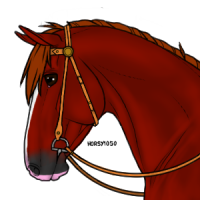Gonna cover Chestnut, Bay, Seal Bay, Wild Bay, Brown, Black, and Grey. Grey is gonna be covered here as well since it’s not really a dilution or modifier as much as it just overruns everything lol
Genetic panel of coverage ee/aa(At/A+)/gg
Not gonna add all shade variants, as many are just slightly different or may just be visually different but not genetically different. This is to cover the genetics as Acronymm has many shades covered above with the CDH rarity guide!
Pretty Title Here!
links to other colors posts and to top post here too
Chestnut
Sorrel, Red, Liver chestnut
- ee/aa
- ee/Aa
- ee/AA
- ee/AAt
- ee/AA+
- ee/Ata
- ee/AtAt
- ee/A+a
- ee/A+A+
Information blob here!
Wild Bay
Alternate names
- Ee/A+a
- EE/A+a
- Ee/A+A+
- EE/A+A+
- Ee/A+A
- EE/A+A
- Ee/A+At
- EE/A+At
Wild Bay is the most dominate Agouti (A+) genetic within Cupido Draft Horses.
Bay
Alternate Names
- Ee/Aa
- EE/Aa
- Ee/AA
- EE/AA
- Ee/AAt
- EE/AAt
Bays will be red on their body and head, with black points. The black points include legs,
muzzle, tail, mane, and occasionally ear tips. The Agouti (A Gene) restricts the black
pigment from the Extension (E Gene).
Seal Bay
Dark Bay, Brown
- Ee/Ata
- EE/Ata
- Ee/AtAt
- EE/AtAt
Seal Bays are the least dominate Agouti (At Gene) in Cupido Draft Horses. The At Gene
provides minimal black restriction on the bay base. Often leaves the soft spots, such as
the muzzle, flanks, and under rump, with more red or orange color. In some cases, the
horse may look black even.
Black
alternate names to this coat! Yay!
Expression of the extension gene, allowing a horse to be a variety of shades of black.
Grey
Gray
Information blob here!












